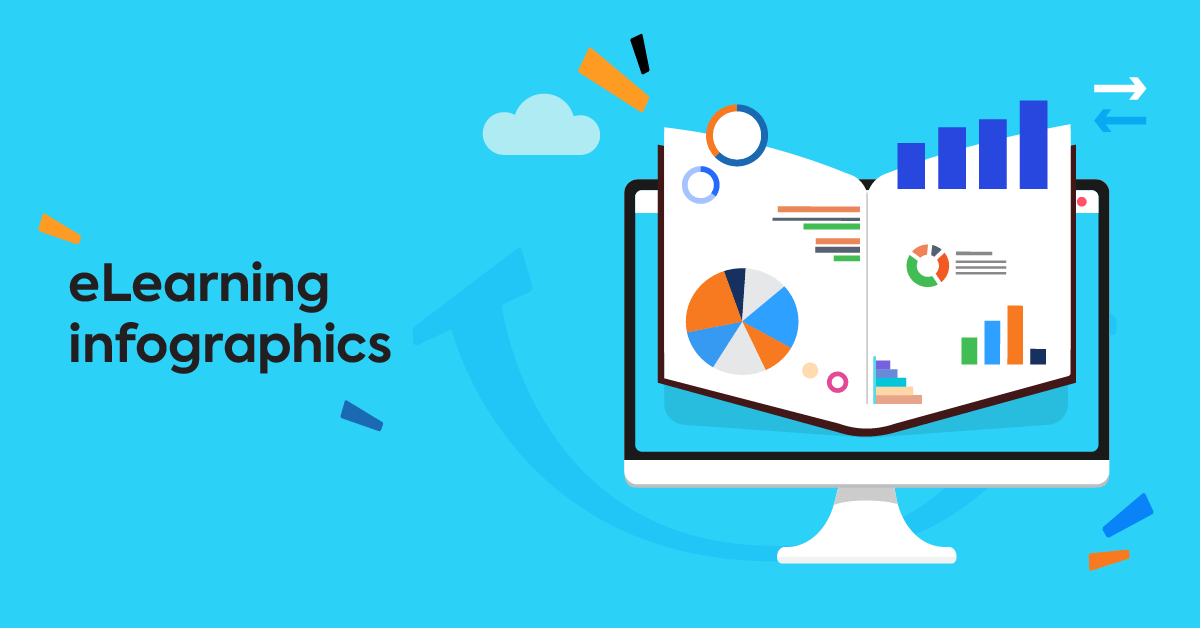Want to capitalize on eLearning infographics, but don’t know how to create them? No problem. If you haven’t got your own in-house designer (or you do, but they’re overstretched), there are lots of great tools on the market to help you produce high-spec, high-performing infographics in minutes.
Read on for our selection of some of the best. But, first a bit of background…
Why use infographics for online training
If you’re considering including infographics in your online training toolkit, you’re not alone. Lots of people absorb and retain information more effectively when it’s communicated visually. And content creators in almost every industry have been quick to capitalize on the power of infographics to engage and enlighten audiences — eLearning designers included.
There’s much more to eLearning infographics than putting a collection of graphics on a page. So, let’s look a little deeper at what makes them so effective.
Some of the reasons infographics work well in an eLearning environment are because they:
- Make stats stick: Share and compare different sets of data relating to company growth, for example, using a 1-page infographic, which includes charts or trends.
- Join the dots: Break complex concepts, such as the reasons for workplace harassment, down into bite-size chunks and visually show the connections and conclusions all in one place.
- Breakdown boundaries: Use a geographic-based infographic to illustrate at-a-glance where your customers or clients are around the world. Qualify this with data specific to each location (for example, preferred methods of communications, time zone information, and sales figures).
- Clarify process: Highlight the steps involved in using a particular piece of equipment, for example, by taking technical information and translating it into a series of visual aids.
- Tell a story: Capture the growth of your business or track sales over a period of time using a timeline infographic, which plots key events and milestones.
- Get people talking: Engage employees in an internal communications campaign (e.g., dress code, diversity, or information security) by using impactful infographics that capture attention and spark conversations.
- Make business sense: Create topic-focused infographics that make it easy for employees to apply what they’ve learned to their job. Less seat time required to complete your online training delivers a better ROI for you and a better experience for them.
Add infographics to your online training courses
and build an engaging learning experience with TalentLMS.
The training platform that users consistently rank #1.

10 of the best eLearning infographic tools
The market is rich with infographic tools for online training. And many of these are free. The most popular free infographic tools on the market also have paid-for options which allow access to greater resources and functionality.
The list we’ve compiled here is by no means definitive but highlights some of the most popular options, best-suited to eLearning infographics.
1. Adobe Spark
Sharing your infographic on social media is made super easy with Adobe Spark. Just choose a template and assets and, once you’ve finished building your creation, resize it in one click to share on your chosen social network.
Or, download and save it as a JPG or PNG. Part of the Adobe Photoshop and Illustrator family, Spark will appeal to those familiar with Adobe’s tools, interface, and user experience.
2. Animaker
Want to animate your infographic but don’t have a digital video expert in-house? Animaker can help. This cloud-based tool opens the door to a rich resource of icons, maps, charts, and royalty-free tunes, which you can personalize to tell your eLearning story.
Just pick a template or video, then drop it into the graphic editor to customize. Note: You’ll need Flash Player.
3. Canva
Accessed through a browser or mobile app, Canva is good for collaboration or on-the-go content creation. As well as providing a wide range of free templates to use, there’s also the option to include images from your own library.
Drag and drop functionality makes it easy and quick to include your own widgets. Adding or editing text is also straightforward and smooth.
4. Easelly
Unlike most free infographic tools which host a vast range of content templates, Easelly focuses purely on infographics.
Its uncompromising, singularly focused approach makes it perfect if you just want to crack on and create a clear, customized instructional infographic, with no distractions. As well as providing templates, there’s the option to embed images and videos from YouTube.
5. Genially
Sometimes small touches make a big difference. Genially categorizes infographics into either vertical or horizontal layouts in its template library. Establishing the layout of a page is the starting point of any design, and making this easy to establish from the outset is a great time-saver.
Primarily a tool for producing interactive content, another of Genially’s standout features is that it offers a more eclectic and arty mix of designs.
6. Infogram
If complex data sets or stats form the basis of your content, Infogram’s data visualization tools are the perfect match.
Simply input your data and Infogram will translate it into a design that brings your dry data to life. To support this data-centric approach, analytics, tracking, and reporting options are also available.
7. Piktochart
With a rich resource of step-by-step tutorials combined with a well-designed and easy-to-use platform, Piktochart is a good option for those who may benefit from a little more guidance.
It comes with all of the standard tools, including templates and multimedia integration, although — be warned — if you’re on the free plan, the end result will contain the Piktochart watermark.
8. Snappa
Out of all the free infographic tools on the market, Snappa’s free plan packs a powerful punch offering almost everything cost-free, apart from unlimited downloads. Choose from millions of high-resolution images and pre-made templates, add text and graphics, remove image backgrounds in a click, and publish on social media without leaving the platform.
Its approach is fun and vibrant, and particularly suitable if you’re looking to increase employee engagement in a topic or campaign.
9. Venngage
Ease of customization to support branding makes Venngage a bit hit with larger organizations in particular.
Other standout features include: the ability to update an infographic as and when you need, a neat library of different infographic types, a regularly updated gallery of design ideas, and a super simple, (“1. Choose a template. 2. Add charts and visuals. 3. Customize”) 3-step process.
10. Visme
A great all-rounder, Visme is popular with a wide range of user types. It boasts a vast range of pre-prepared assets combined with drag-and-drop functionality so you can create your infographic in minutes.
Need to add something in? Customizable content blocks mean you can do this without having to rearrange everything else on the page. There’s even the option to animate or include video and audio content — including recording your own voiceover.

Over to you
So, the good news is if you want to include instructional infographics within your online training courses, there’s nothing stopping you. As we’ve seen, there are plenty of great tools around to help you produce professional and personalized eLearning infographics quickly, cost-effectively, and creatively.
But eLearning infographic tools won’t make all of the decisions for you. There are a few important questions only you can answer, such as:
- What’s your key message and is an infographic the right format for delivering that message?
- Have you used the appropriate infographic type for your content?
- Will your design complement the content or does it overshadow your most important pieces of information?
- Does your training platform (if you’re using one) support infographics? For example, a platform like TalentLMS is compatible with all media types, but many aren’t.
- And, most importantly, which infographic tool is right for you?
Infographics in isolation aren’t enough to populate an entire course, but they can be an effective addition to your online training content. Just remember to spend a bit of time planning your strategy and matching up your requirements with the right infographic tool, and the rest will follow smoothly.



